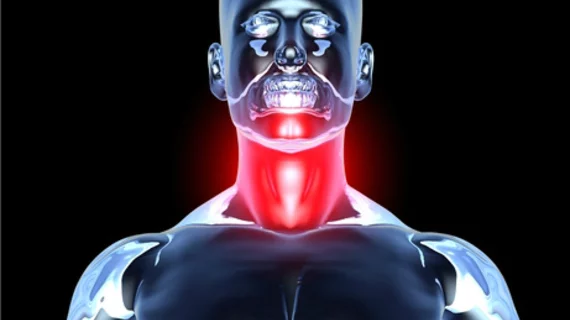PET/CT findings predict post-treatment, radiation-induced hypothyroidism
In patients who undergo radiation therapy treatment for head and neck cancers, 18F-FDG PET/CT-derived thyroid functioning volume is a good indicator of who will develop radiation-induced hypothyroidism [1].
Radiation-induced hypothyroidism (RIHT) is an adverse effect that manifests typically years after patients have completed treatment. Although it is common, it is still underdiagnosed, partially due to its minute symptoms but this is more likely owed to a lack of follow-up consensus in patients treated with RT for head and neck cancers.
This is what led researchers to investigate the prognostic value of early post-treatment 18F-FDG PET/CT exams in predicting the onset of radiation-induced hypothyroidism. For their study, the experts included 53 patients who had undergone radiotherapy for nasopharyngeal or oropharyngeal cancer, each of whom also completed a 18F-FDG PET/CT scan within 180 days of their final treatment.
RIHT occurred in 42% of patients. In the patients who developed RIHT, thyroid functioning volume was noted to be significantly lower. Pretreatment thyroid volume and mean radiotherapy dose to the thyroid also differed between the groups. Combining 18F-FDG uptake and a thyroid functioning volume cutoff of 14.01 yielded an AUC of .89, as well as high sensitivity, specificity and positive predictive value in predicting which patients would develop RIHT.
The experts noted that the date of post-treatment imaging preceded the onset of patients’ abnormal thyroid function by a median of 1.5 years. Given that the severity of RIHT increases over time, the researchers suggested that this time interval should be considered in the establishment of post-treatment screening guidelines.
“Although screening for RIHT is recommended after head and neck radiotherapy, the optimal screening interval remains unknown. In patients with low risk, infrequent screening at intervals of 1–2 years may be adequate, while scrupulous screening every 3–6 months may be required for high-risk patients,” corresponding author of the study Mu-Hung Tsai, with the Department of Radiation Oncology at National Cheng Kung University Hospital, and colleagues explained, adding that pathological thyroid uptake on PET/CT could even precede serum irregularities.
The authors went on to suggest that patients with these findings on imaging should be considered high-risk and have their thyroid function monitored frequently.
The study can be viewed in full in Cancer Imaging.

